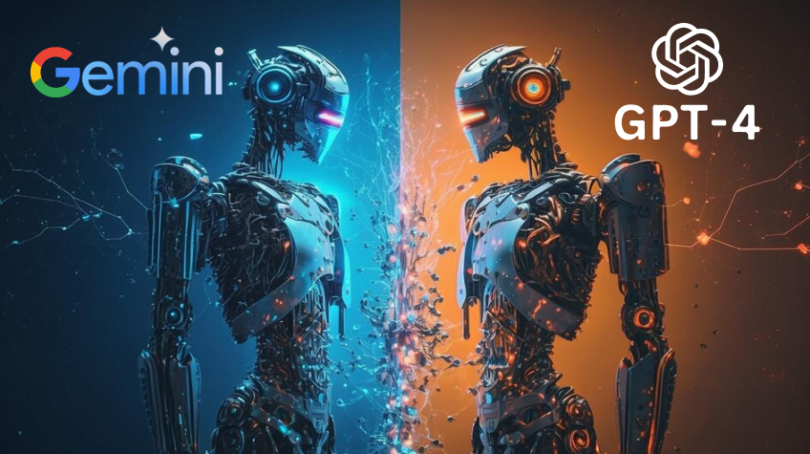Google Gemini and OpenAI ChatGPT are two of the most advanced AI language models in the world. They have different strengths and weaknesses, depending on the task and the desired outcome. Here is a brief comparison between Google’s Gemini and OpenAI ChatGPT AI models:
- Google Gemini is a family of three AI models: Gemini Ultra, Gemini Pro, and Gemini Nano. They are designed to process text, images, and video simultaneously, and to perform tasks across different domains and modalities. Gemini Ultra is the most powerful and the most accurate, but also the slowest and the most expensive. Gemini Pro is the most scalable and the most versatile, and it is currently used for Bard, Google’s chatbot. Gemini Nano is the most efficient and the most suitable for on-device tasks, such as summarizing audio recordings or generating smart replies. Google plans to integrate Gemini into its products and services, such as Search, Ads, Chrome, and Duet AI. Gemini is available for licensing via Google Cloud.
- OpenAI ChatGPT is a single AI model that specializes in generating natural language text. It can produce long, coherent, and creative texts on various topics and styles, such as stories, essays, jokes, tweets, etc. ChatGPT can also engage in open-ended and subjective conversations with humans, using its knowledge, personality, and emotions. ChatGPT is powered by GPT-4V, the latest version of OpenAI’s generative pre-trained transformer model. ChatGPT is accessible via OpenAI Playground, a web-based platform that allows anyone to interact with the model for free.
How does Google Gemini compare to OpenAI ChatGPT in terms of performance?
Google Gemini and OpenAI ChatGPT are two of the most advanced AI language models in the world, but they have different strengths and weaknesses, depending on the task and the desired outcome. In terms of performance, there are several aspects to consider, such as accuracy, speed, scalability, versatility, and cost. Here is a brief comparison of the two models in these aspects:
- Accuracy: Google Gemini claims to achieve state-of-the-art performance in 30 out of 32 academic benchmarks that are used in large language model development. However, some critics have questioned the validity and relevance of these benchmarks, and suggested that Google may have cherry-picked the examples that favor Gemini. OpenAI ChatGPT, on the other hand, has not released any official benchmarks, but it has demonstrated impressive natural language generation and understanding skills, as well as creativity and collaboration with users. Therefore, the accuracy of the two models may depend on the specific domain and task, and it may not be easy to compare them objectively.
- Speed: Google Gemini comes in three versions: Gemini Ultra, Gemini Pro, and Gemini Nano. Gemini Ultra is the most powerful and the most accurate, but also the slowest and the most expensive. Gemini Pro is the most scalable and the most versatile, and it is currently used for Bard, Google’s chatbot. Gemini Nano is the most efficient and the most suitable for on-device tasks, such as summarizing audio recordings or generating smart replies. OpenAI ChatGPT is a single model that specializes in generating natural language text. It can produce long, coherent, and creative texts on various topics and styles, such as stories, essays, jokes, tweets, etc. Therefore, the speed of the two models may vary depending on the size and capability of the model, the type and amount of data, and the use case and application.
- Scalability: Google Gemini is designed to process text, images, and video simultaneously, and to perform tasks across different domains and modalities. The innovative architecture used by Gemini combines a multimodal encoder and decoder. It is the encoder’s responsibility to translate various data kinds into a language that the decoder can comprehend. Subsequently, the decoder assumes responsibility, producing outputs in various modalities according to the encoded inputs and the current task. OpenAI ChatGPT is powered by GPT-4V, the latest version of OpenAI’s generative pre-trained transformer model. ChatGPT can also engage in open-ended and subjective conversations with humans, using its knowledge, personality, and emotions. Therefore, the scalability of the two models may depend on the complexity and diversity of the data and the task, and the availability and compatibility of the hardware and software resources.
- Versatility: Google Gemini is intended to be the most versatile AI model ever built, and Google plans to integrate it into its products and services, such as Search, Ads, Chrome, and Duet AI. Gemini can also work with other data types, such as audio, graphs, maps, etc., and combine them in various ways. OpenAI ChatGPT is focused on natural language processing, but it can also perform other tasks, such as coding, math, music, etc., by leveraging its large and diverse training data. Therefore, the versatility of the two models may depend on the range and flexibility of the tasks and the outputs, and the adaptability and generality of the models.
- Cost: Google Gemini is available for licensing via Google Cloud, but the pricing for Google Gemini is not publicly disclosed, and it may vary depending on the size and capability of the model, the type and amount of data, and the use case and application. According to some reports, Google has given select companies early access to Gemini, signaling an upcoming release. However, the licensing process is not straightforward, and it requires a lot of technical and financial resources. According to Google, Gemini is intended for enterprise-level applications, and not for personal or hobbyist use. OpenAI ChatGPT is accessible via OpenAI Playground, a web-based platform that allows anyone to interact with the model for free. However, the platform has some limitations, such as the number of tokens, the response time, and the availability of the model. To access the full power and potential of ChatGPT, users need to apply for OpenAI Codex, a private beta program that provides access to GPT-4V and other OpenAI models. Therefore, the cost of the two models may depend on the level and quality of the access and the service, and the demand and supply of the market.
The answer to which model is better in terms of performance depends on the specific use case and the desired outcome. For tasks that require short, concise responses that are highly relevant to the context, Gemini may be the better choice. On the other hand, if the goal is to generate longer, more elaborate text that is engaging and creative, ChatGPT may be the better option.
Use case example for Gemini Ultra
Gemini Ultra is the largest and most capable model in the Gemini family of AI models. It is designed for highly complex tasks that require processing text, images, and video simultaneously, and performing tasks across different domains and modalities. One example use case for Gemini Ultra is to power Bard, Google’s chatbot that can answer any question and generate any content. Bard is currently powered by Gemini Pro, but Google plans to upgrade it to Gemini Ultra in the future.
- Another example use case for Gemini Ultra is to enable data analysis and visualization for enterprise applications. Gemini Ultra can ingest large amounts of data from various sources, such as spreadsheets, databases, web pages, etc., and generate insights, summaries, charts, graphs, etc., that are relevant and accurate
- Gemini Ultra can also interact with users via natural language, voice, or gestures, and provide explanations and recommendations based on their queries and preferences.
Can I use Google Gemini for my own chatbot?
Google plans to integrate Gemini into its products and services, such as Search, Ads, Chrome, and Duet AI. Gemini is available for licensing via Google Cloud.
- However, the licensing process is not straightforward, and it requires a lot of technical and financial resources. According to Google, Gemini is intended for enterprise-level applications, and not for personal or hobbyist use.
- Therefore, unless you have a very compelling reason and a very large budget, you cannot use Google Gemini for your own chatbot. You might want to consider other AI models that are more accessible and affordable, such as OpenAI ChatGPT, Microsoft Azure Bot Service, or IBM Watson Assistant.
How does Google Gemini work with images, videos and text?
Google Gemini is a family of three AI models that are designed to process text, images, and video simultaneously, and to perform tasks across different domains and modalities. The innovative architecture used by Gemini combines a multimodal encoder and decoder. It is the encoder’s responsibility to translate various data kinds into a language that the decoder can comprehend. Then, depending on the encoded inputs and the current task, the decoder takes over and generates outputs in different modalities.
For example, Gemini can take a video as an input and generate a text summary of its content, as well as answer follow-up questions about the video. Gemini can also take a text as an input and generate an image or a video that matches the text description. Gemini can also work with other data types, such as audio, graphs, maps, etc., and combine them in various ways.
Gemini is expected to be the most powerful AI ever built, and Google plans to integrate it into its products and services, such as Search, Ads, Chrome, and Duet AI. Gemini is also available for licensing via Google Cloud.
Can I use ChatGPT for my chatbot?
With ChatGPT, an AI-powered natural language processing tool, you may converse with the chatbot in a manner akin to that of a human and accomplish a lot more. The language model can answer questions and assist you with tasks, such as composing emails, essays, and code. ChatGPT is accessible via OpenAI Playground, a web-based platform that allows anyone to interact with the model for free.
However, the platform has some limitations, such as the number of tokens, the response time, and the availability of the model. To access the full power and potential of ChatGPT, users need to apply for OpenAI Codex, a private beta program that provides access to GPT-4V and other OpenAI models. Therefore, if you want to use ChatGPT for your chatbot, you need to consider these factors and decide whether it meets your needs and expectations. You might also want to compare ChatGPT with other AI models that are more accessible and affordable, such as Microsoft Azure Bot Service, or IBM Watson Assistant.






